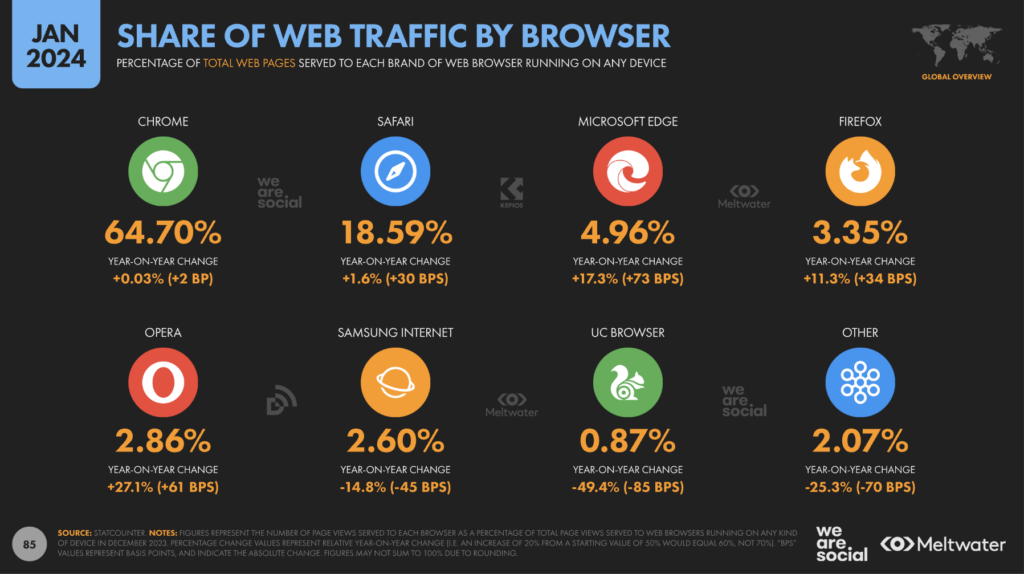Learning Intentions
- Understand web browsers and their role in web development, including browser compatibility and cross-browser testing.
- Recognise different browser engines and their impact on webpage rendering and performance.
- Learn to use browser developer tools for inspecting, debugging, and optimising web applications across various aspects like CSS, JavaScript, and network activity.
Syllabus Outcome
SE-12-03 analyses how current hardware, software and emerging technologies influence the development of software engineering solutions
Lesson Activity
Developer Tools activities and
Self-marking Quiz
Introduction to Web Browsers and Their Role in Web Development
Web browsers like Chrome, Firefox, Edge, and Safari are the tools we use to view websites. But did you know that each browser can display the same website a bit differently? This happens because different browsers have their own ways of interpreting and showing the code that makes up a website.
As a web developer, it’s important to understand how these differences can affect what users see and experience. This is why we talk about browser compatibility. It’s about making sure your website works well on all popular browsers, so no one misses out just because they’re using a different one.
To make sure everything works as it should across different browsers, we do something called cross-browser testing. This involves checking how your website looks and behaves in different browsers and fixing any issues that might pop up. This way, you ensure a smooth experience for everyone, no matter what browser they’re using.

Browser Engines
At the heart of every web browser is something called a browser engine. It’s like the brain of the browser that reads the website’s code and turns it into the pages you see on your screen. Different browsers use different engines, like Blink in Chrome, Gecko in Firefox, and WebKit in Safari.
These engines play a huge role in how fast a page loads, how it looks, and how it behaves. For example, one engine might handle animations more smoothly, while another might be faster at loading images. Understanding these differences helps you create websites that look good and work well, no matter which engine is used to view them.
Below are some of the current engines being used by a number of browsers. A large number of browsers currently are built on chromium, the base code behind Google Chrome.
Comparison of Browser Engines
Source: Comparison of browser engines – Wikipedia
Cross-browser Compatibility
As mentioned in the previous lesson on HTML, when developing web applications, not every feature of HTML, CSS, or JavaScript might be supported, and it is important to be aware of that so that every user sees exactly what you want them to see. The website, caniuse.com, allows you to compare browsers supported features, as demonstrated below:

Introduction to Developer Tools

Developer tools, or dev tools, are like a secret toolkit built right into web browsers. Every major browser—like Chrome, Firefox, and Edge—has them, and they’re incredibly useful for web developers.
These tools let you see what’s going on behind the scenes of any website. You can check out the HTML, tweak the CSS, debug JavaScript, and much more. To access these tools, you can usually just press F12 on your keyboard or right-click on a webpage and select ‘Inspect’. Once you’re in, you can explore and play around with the code to see how it all works.
These tools let you see what’s going on behind the scenes of any website. You can check out the HTML, tweak the CSS, debug JavaScript, and much more. To access these tools, you can usually just press F12 on your keyboard or right-click on a webpage and select ‘Inspect’. Once you’re in, you can explore and play around with the code to see how it all works.
Source: What are browser developer tools? – Learn web development | MDN

Lesson Activity
Read the overview section of the Chrome DevTools website.
Your next task will be to complete each activity from the DevTools site below:
- View and change CSS
- Watch JavaScript values in real time
- Debug Javascript
- Inspect network activity
- Analyse runtime performance
Debug Progressive Web Apps

This activity will be useful for your PWA you will be creating at the end of the Programming for the Web subject.
Read the ‘Debug Progressive Web Apps‘ page on the Chrome DevTools website. Some of the information on that page will likely be new to you, but as you move further into the subject, more will become clear.

Complete the self-marking quiz below based on what you have learned this lesson.
Results
HD Quiz powered by harmonic design
